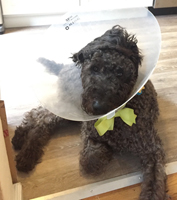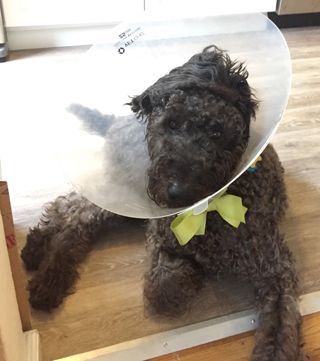
Koji 320

Photo by Kate Macfarlane
Elizabethan collars, such as the one Koji sported after his neuter surgery in 2017, can help prevent evisceration and self-cannibalizing in dogs who have had abdominal operations. However, those phenomena are rare enough that the authors of a new study on the subject don't recommend E-collars as a matter of routine during recovery from abdominal surgery.
Dr. Mark Rishniw will never forget a case from about 30 years ago, when he was practicing in Melbourne, Australia. He was greeted at the clinic door one morning by a worried veterinary technician, who hurried him to a kennel. There waited a young yellow Labrador retriever, her tail wagging and her intestines snaking out of her abdomen and into a plastic bag at her side.
The dog had been admitted the previous evening because sutures from a spay surgery had begun to come apart. The situation was not considered urgent, so the plan was to re-stitch the incision the following day. However, during the night, the patient licked and chewed at her underbelly, creating a frightful wound. The technician did what she could by saving the spillover in the bag. Rishniw rushed the dog into surgery, where he washed and sutured the intestines, replaced them and closed the incision.
Everything was going well until he removed the endotrachael tube used during surgery to keep the dog's airway open. He was shocked to discover blood on it. He checked the dog's mouth and spotted something at the back of her throat.
"I grab it with a pair of hemostats and pull," he said, recounting the experience for the VIN News Service by email. "And out comes 18 inches of her intestine."
The dog had eaten her own insides.
Rishniw had never heard of this before and thought that the case was unique. "Turns out, I was wrong," he said. When he told the story a few years ago over beers with colleagues, two veterinarians said they'd had similar experiences. That made Rishniw wonder: How commonly are dogs accidentally eviscerated after surgery? How frequently do they then self-cannibalize, or autocannibalize? And what becomes of those dogs?
These questions soon became part of a survey emailed to more than 38,000 members of the Veterinary Information Network, an online community for the profession, for which Rishniw is director of clinical research. VIN is the parent of VIN News. Rishniw also is an adjunct professor at the Cornell University College of Veterinary Medicine.
The results, "Post-surgical evisceration with or without autocannibalism in 333 dogs — a survey of veterinarians," co-authored by Lori Kogan, a professor of clinical sciences at Colorado State University College of Veterinary Medicine and Biomedical Sciences, were published in Open Veterinary Journal Sept. 12, 2019.
The survey drew 525 responses from veterinarians. Of these, 260 (50%) reported seeing one case; and 32 (6%) reported seeing two or three, for a total of 333 cases.
"What was interesting, or somewhat surprising, was the frequency with which this happens," Rishniw said. "It's not 'common,' but it's more than a unique case."
Of the reported cases, 221, or 66%, involved evisceration and self-cannibalism, while 112 concerned evisceration only.
Rishniw said he and Kogan were also surprised at the frequency of self-cannibalism. "Wound breakdown (and evisceration) is one thing – that might be reasonably expected," he said. "But then to actually have the dog eat its own gut contents, well, that's a different story!"
That begs the question, why would a dog do that? Rishniw and Kogan surveyed veterinarians, not dogs, so that's not a question their paper answers, but anyone who's ever known a dog with indiscriminate tastes can speculate.
What veterinarians can say is that intestines don't have the type of pain receptors that would transmit the pain of cutting and might otherwise stop a dog from biting its own organ.
The overall long-term survival rate for all the reported cases was 64%; in other words, 205 dogs lived. Survival was better for dogs who did not eat their viscera, in part because those who did were euthanized without an attempt at surgical repair.
"Being confronted with this scenario as a vet is horrifying — you have a literal mess in front of you, and you need to decide if it's too far gone or not," Rishniw said. "Our study suggests that it's at least worth trying to repair things."
That's what he did with his case 30 years ago. Rishniw opened up the dog again and checked the intestine from stomach to rectum to be sure there wasn't anything else that needed repair. There wasn't. He closed her up once more, and kept her well sedated afterward. The dog was outfitted with an Elizabethan collar (E-collar, colloquially known as the "cone of shame") for the remainder of the healing process and made a full recovery.
Rishniw and Kogan's survey expands on a study by Dr. Sara B. Gower and others published in the Journal of American Veterinary Medical Association in 2009. That study covered 12 cases of evisceration following abdominal surgery between 1998 and 2008. All of the dogs received specialist care at a university hospital and survived. In contrast, respondents to the VIN survey comprised general practitioners and emergency clinic veterinarians.
The Gower study did not address self-cannibalism specifically. However, it reported that four dogs required resection of "compromised intestines." In another study, Gower reported on 13 dogs that required "extensive resection," most of which had a good outcome. Those studies found no association between the amount of intestines resected and the outcome.
Rishniw and Kogan wrote: "Our data, along with outcomes of these previous studies, should encourage clinicians to attempt surgical repair, even if the dog has ingested some of its viscera."
Their survey also asked about the initial surgery, including reason for the surgery; suture pattern; number of days between initial surgery and evisceration; use of pre- and post-operative analgesia; and whether the dog wore an E-collar after the surgery.
In addition, the survey collected data on breeds, age and ownership (such as "established family pet" versus "recently obtained").
The data in these areas were suggestive but not conclusive.
There were over-represented breeds, including Labrador retrievers. "But some of these [breeds] are just very popular, so we can't really say that Labradors are 'more prone to it,' " Rishniw said, adding, "although we know that to a Labrador, everything is edible until proven otherwise!"
The fact that younger dogs predominated in the survey could indicate evisceration and self-cannibalism is more common among younger dogs, he said, but it could be due to the fact that older dogs are less likely to undergo abdominal surgery.
Survey participants reported that only 9% of dogs were wearing E-collars at the time of the event. But the authors said that due to the relatively infrequent nature of evisceration after abdominal surgery, they could not recommend E-collars become standard of care.
The authors also said the information should be interpreted cautiously because the veterinarians participating in the survey provided reports based on memory and not a review of medical records.
"The good news is that something like this is infrequent and gruesome enough that it sticks in your memory!" Rishniw said. "Mine certainly did."